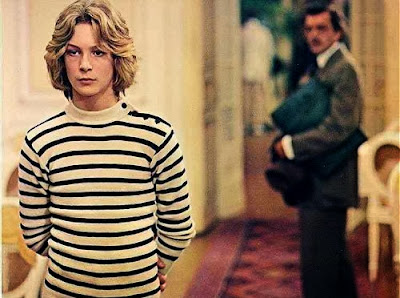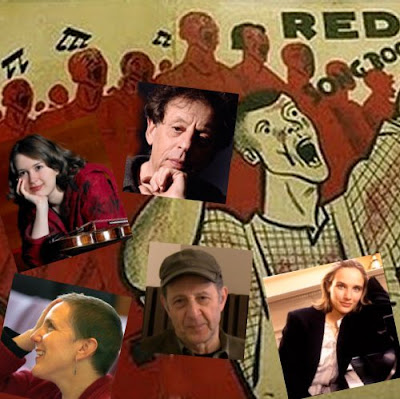Music to listener or listener to music?
My post Beware of creating museums of sound, the latest in a long running thread about shifting sonic expectations, generated one of the largest readerships in the ten year history of On An Overgrown Path. That readership was boosted by exposure on Synthtopia, a Facebook portal devoted to electronic music. However, there and elsewhere a number of readers interpreted the article as a plea for the use of sound shaping to correct the sound of acoustically deficient halls, and there were the usual comments such as Paul Kavicky's "This is the stupidest thing I've read all day". Paul and others missed the point that my post was not about corrective technologies, but about bridging the yawning gap between traditional concert hall sound and the ubiquitous headphone/MP3 sound. Despite the naysayers, there is no need to argue the case for using corrective sound shaping. Because, as Alex Ross pointed out in a recent New Yorker article, corrective sound shaping is a done deal that is in place, working and accepted in traditional venues around the world such as the Konzerthaus in Berlin. The Meyer Sound system described in Alex's article is one accepted sound shaping solution, another is the French 'Carmen' system which was featured here as far back as 2010.
Judging by the reaction to my post a lot of people in classical music remain in denial about sound shaping technologies. But one reader who is definitely not in denial is Ian Sidden, who is a baritone in Theater Dortmund Opera's chorus. In a post on his blog linked to my museums of sound piece Ian recounts how:
I do remember when I was first becoming acquainted with live classical music (as an audience member, since I’ve often participated onstage in some form or another since childhood), and I was deeply surprised by how different my CDs sounded vs. what happened in the concert hall. I love it now, but if the preparation for new classical listeners is recorded music, then those first experiences will be jarring.It is that jarring discrepancy between concert hall and recorded sound - a discrepancy which has increased since Ian was a classical neophyte - which is so important. Last year I wrote another post which drew mixed reactions, it was about MP3s and other lossy audio files and was titled How classical music was covertly dumbed down. Since I wrote that post a startling illustration of how recorded music is being covertly dumbed down comes from Ryan Maguire, a Ph.D. student in Composition and Computer Technologies at the University of Virginia Center for Computer Music. In a project pointedly titled The Ghost In the MP3, Ryan has extracted the sounds lost to MP3 compression in Suzanne Vega’s song Tom’s Diner, and has made those sounds available as a 'ghost' soundtrack. Listening to that ghost soundtrack is certainly an ear opener, and this is pop music - just think what is lost from a sonically more complex classical recording. The diluting effect of digital compression is receiving much attention, but the conditioning effect resulting from compressed binaural sound becoming the listening norm is still receiving little attention.
Alex Ross' New Yorker article opens in a trendy Californian restaurant, and the Ghost in the MP3 deconstructs Tom's Diner. So, to trigger some reasoned debate, let's construct a foodie analogy. Classical music in a traditional concert hall is like a restaurant serving only tofu salad. That restaurant has three big problems. First the market for tofu salad is shrinking, secondly the restaurant owners have written a very ambitious growth oriented business plan based on moving into the mass market, and thirdly the owners have hired several highly-paid celebrity chefs. The health benefits of tofu salad are a no brainer; but the reason why the market is shrinking is that diners increasingly prefer hamburgers - aka headphone/MP3 sound. So what should the restaurant owners do? Should they keep serving tofu salad and nothing else in the hope that diners will see the error of their ways? Which is what classical music is currently doing. Or should the restaurant pursue alternative strategies instead of simply sitting, waiting and hoping that the market will change? Taking tofu salads off the menu and replacing them with hamburgers is not an atractive option as it means losing the existing customers. Offering a choice of tofu and hamburger menus on different days is another option that would attract new custom, while putting tofu hamburgers on the everyday menu is another possibility. Which solution, if any, will work is unclear, and the only way to find out is to experiment.
Sound shaping technologies mean that a concert hall with a traditional circa 1.8 second resonance can now also experiment with frequency shaped 'up close and personal' surround sound - which means that tofu salad, hamburgers and tofu hamburgers are available on demand to meet the needs of different audiences. Those in denial about digital solutions should also take on board the possibility that the non-digital solution of smaller halls with more engaging acoustics may be the answer. The fashion is for large concert halls created by designer architects to accommodate the large audiences demanded by classical music's profligate financial model, and by the large orchestras demanded by the current fixation with overblown late-Romantic symphonies. Smaller and more intimate halls - tofu hamburgers? - may be the way forward. Don't forget that Snape Maltings, which is acclaimed as one of the best concert halls in the world, seats only 800 compared with the acoustically-challenged Royal Festival Hall's capacity of 2900. One of the complex factors that makes the Snape sound so winning is the hall's apparent 'loudness'. Smaller venues would bring the dual benefit of bringing a more involving sound and, due to the reduced audience capacity constraining revenue generation, bringing celebrity musicians back into the real world.
As someone who believes in Nadha Brahma - sound is god - it pains me to say so, but, whether we like it or not, headphone/MP3 sound has become the mass market reference. In an ideal world we would take the listener to the music in a traditional concert hall acoustic, and not the music to the listener using intermediary technologies. But the important and overlooked point is that there is actually no such thing as listener to the music. Because in a traditional concert hall the music is taken to the listener using a set of acoustic conventions determined more than a century ago, just as recorded music is taken to another audience via MP3 files and headphones using a new set of conventions. Bridging the gap between those two conventions could be the way to solve classical music's new/young audience problem, and accepting that the gap actually exists is the first step towards arriving at a solution. Now excuse me while I finish my tofu salad.
Header photo comes via the Train in Vain blog. Any copyrighted material on is included as "fair use" for the purpose of r critical analysis only, and will be removed at the request of copyright owner(s). Also on Facebook and Twitter.










Comments
I would not use "tofu salad" to describe the live orchestra sound. I'm not sure if you meant to, but this analogy to me denotes the idea that the live orchestra sound is bland and flavorless, when in fact compared to almost any recorded music it is rich and colorful and more dynamic than anything you can fit into the earbuds.
So I would flip the analogy around. The live band in a good room with minimal amplification is like an actual meal whereas the recording is a photograph of said meal: flat, dimensionless and lacking in flavor.
Of course, I may have just made your point for you, I'm not sure.
My other thought is that recordings are not really the right benchmark for the "sound" that the earbud people expect. The real sound to consider is the live amplified pop music show, and this is a completely different thing than either the traditional concert hall or the studio recording.
Again my bias will come out here. I can count on the fingers of one hand the number of live amplified shows that I've been to where you could actually hear the music under all the garbage that the PA put into the sound. What you hear in most smaller clubs or even concert halls is a constant drone of the bass notes with undefined and unintelligible vocals and other instruments floating in and out on top. But it sounds nothing like the recorded music the group might have created to get you to the show in the first place. If we really want to educate people about the sound of music, showing them that almost all live music sounds terrible would be the place to start.
That said, I have no problem with this electronic improvement of marginal room acoustics. If it's done well and the orchestra still sounds like itself instead of some weird electronic simulation of itself then I'm all for it.